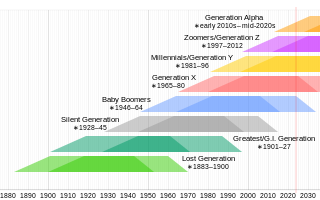Media literacy is an expanded conceptualization of literacy that includes the ability to access and analyze media messages as well as create, reflect and take action, using the power of information and communication to make a difference in the world. Media literacy is not restricted to one medium and is understood as a set of competencies that are essential for work, life, and citizenship. Media literacy education is the process used to advance media literacy competencies, and it is intended to promote awareness of media influence and create an active stance towards both consuming and creating media. Media literacy education is part of the curriculum in the United States and some European Union countries, and an interdisciplinary global community of media scholars and educators engages in knowledge and scholarly and professional journals and national membership associations.

Ephebiphobia is the fear of youth. First coined as the "fear or loathing of teenagers", today the phenomenon is recognized as the "inaccurate, exaggerated and sensational characterization of young people" in a range of settings around the world. Studies of the fear of youth occur in sociology and youth studies. It is distinguished from pedophobia by being more so focused on adolescents than prepubescent children.
Mass communication is the process of imparting and exchanging information through mass media to large population segments. It is understood as relating to various forms of media, as its technologies are used for the dissemination of information, of which journalism and advertising are part. Mass communication differs from other types of communication, such as interpersonal communication and organizational communication, because it focuses on particular resources transmitting information to numerous receivers. The study of mass communication is chiefly concerned with how the content of mass communication persuades or otherwise affects the behavior, attitude, opinion, or emotion of the people receiving the information.
In media studies, mass communication, media psychology, communication theory, and sociology, media influence and themedia effect are topics relating to mass media and media culture's effects on individual or an audience's thoughts, attitudes, and behavior. Whether it is written, televised, or spoken, mass media reaches a large audience. Mass media's role and effect in shaping modern culture are central issues for study of culture. At present, mass media is the mainstream trend of media development, information dissemination presents the characteristics of diversification and interaction, and its influence on social life is also constantly expanding.

Alcohol advertising is the promotion of alcoholic beverages by alcohol producers through a variety of media. Along with nicotine advertising, alcohol advertising is one of the most highly regulated forms of marketing. Some or all forms of alcohol advertising are banned in some countries. There have been some important studies about alcohol advertising published, such as J.P. Nelson's in 2000.
Children's culture includes children's cultural artifacts, children's media and literature, and the myths and discourses spun around the notion of childhood. Children's culture has been studied within academia in cultural studies, media studies, and literature departments. The interdisciplinary focus of childhood studies could also be considered in the paradigm of social theory concerning the study of children's culture.

Generation Z, colloquially known as zoomers, is the demographic cohort succeeding Millennials and preceding Generation Alpha. Researchers and popular media use the mid-to-late 1990s as starting birth years and the early 2010s as ending birth years. Most members of Generation Z are children of Generation X.
Media psychology is the branch and specialty field in psychology that focuses on the interaction of human behavior with media and technology. Media psychology is not limited to mass media or media content; it includes all forms of mediated communication and media technology-related behaviors, such as the use, design, impact, and sharing behaviors. This branch is a relatively new field of study because of advancement in technology. It uses various methods of critical analysis and investigation to develop a working model of a user's perception of media experience. These methods are used for society as a whole and on an individual basis. Media psychologists are able to perform activities that include consulting, design, and production in various media like television, video games, films, and news broadcasting. Media psychologists are not considered to be those who are featured in media, rather than those who research, work or contribute to the field.
"Youth Marketing" is a term used in the marketing and advertising industry to describe activities to communicate with young people, typically in the age range of 11 to 35. More specifically, there is teen marketing, targeting people age 11 to 17, college marketing, targeting college-age consumers, typically ages 18 to 24, and young adult marketing, targeting ages 25 to 34.

Consumer socialization is the process by which young people acquire skills, knowledge and attitudes relevant to their functioning as consumers in the marketplace. It has been argued, however, that consumer socialization occurs in the adult years as well. This field of study is a subdivision of consumer behavior as its main focus is on how childhood and adolescent experiences affect future consumer behavior. It attempts to understand how factors such as peers, mass media, family, gender, race, and culture play an influence in developing customer behavior.
Cyberbullying or cyberharassment is a form of bullying or harassment using electronic means. Cyberbullying and cyberharassment are also known as online bullying. It has become increasingly common, especially among teenagers, as the digital sphere has expanded and technology has advanced. Cyberbullying is when someone, typically a teenager, bullies or harasses others on the internet and other digital spaces, particularly on social media sites. Harmful bullying behavior can include posting rumors, threats, sexual remarks, a victims' personal information, or pejorative labels. Bullying or harassment can be identified by repeated behavior and an intent to harm. Victims of cyberbullying may experience lower self-esteem, increased suicidal ideation, and various negative emotional responses, including being anxious, frustrated, angry, or depressed.

Patricia Maria (Patti) Valkenburg is a Distinguished Professor of Communication at the University of Amsterdam. She is the founder and director of Center for research on Children, Adolescents, and the Media (CCAM). She is a fellow of the International Communication Association. In 2011, she received the Spinoza Prize, the highest Dutch award in science.
The 'effects of advertising on body image have been studied by researchers, ranging from psychologists to marketing professionals. "These days we know that the media and body image are closely related. Particularly, the body image advertising portrays affects our body image. Of course, many other things influence our body image: parenting, education, intimate relationships, and so on. The popular media does have a big impact, though" This is because thousands of advertisements contain messages about physical attractiveness and beauty, examples of which include commercials for clothes, cosmetics, weight reduction, and physical fitness. Researchers have conducted studies in an attempt to see if such advertisements have effects on teenage body image, and what those effects might be.
Gender advertisement refers to the images in advertising that depict stereotypical gender roles and displays. The effects of advertising on body image have been studied by researchers ranging from psychologists to marketing professionals. Advertisements contain messages about physical attractiveness and beauty; examples which include commercials for clothes, cosmetics, weight reduction, and physical fitness. Researchers have conducted studies in an attempt to see what effects, if any, such advertisements have on teenage body image.
Media consumption or media diet is the sum of information and entertainment media taken in by an individual or group. It includes activities such as interacting with new media, reading books and magazines, watching television and film, and listening to radio. An active media consumer must have the capacity for skepticism, judgement, free thinking, questioning, and understanding.Media consumption is to maximize the interests of consumers.
The exploitation of women in mass media is the use or portrayal of women in mass media as objects to increase the appeal of media or a product to the detriment of, or without regard to, the interests of the women portrayed, or women in general. This process includes the presentation of women as sexual objects and the setting of feminine beauty ideals that women are expected to reflect. Sexual exploitation of women in the media dates back to 19th century Paris, in which ballerinas were exposed to harassment and objectification. The ballerinas in the Paris Opera Ballet were ogled by their male audience members and often even expected to perform sexual favors for the male subscribers behind the scenes. Feminists and other advocates of women's rights have criticized such exploitation. The most often criticized aspect of the use of women in mass media is sexual objectification, but dismemberment can be a part of the objectification as well.

Screen time is the amount of time spent using a device with a screen such as a smartphone, computer, television, or video game console. The concept is under significant research with related concepts in digital media use and mental health. Screen time is correlated with mental and physical harm in child development. The positive or negative health effects of screen time are influenced by levels and content of exposure. To prevent harmful exposure to screen time, some governments have placed regulations on its usage.
This article explains the positive and negative impacts to adolescents’ exposure to social media.
The relationships between digital media use and mental health have been investigated by various researchers—predominantly psychologists, sociologists, anthropologists, and medical experts—especially since the mid-1990s, after the growth of the World Wide Web. A significant body of research has explored "overuse" phenomena, commonly known as "digital addictions", or "digital dependencies". These phenomena manifest differently in many societies and cultures. Some experts have investigated the benefits of moderate digital media use in various domains, including in mental health, and the treatment of mental health problems with novel technological solutions.
Controversy surrounds the concept of rapid-onset gender dysphoria (ROGD), proposed as a subtype of gender dysphoria and said to be caused by peer influence and social contagion. ROGD has not been recognized by any major professional association as a valid mental health diagnosis, and use of the term has been discouraged by the American Psychological Association, the American Psychiatric Association, the World Professional Association for Transgender Health, and other medical organizations due to a lack of reputable scientific evidence, major methodological issues in existing research, and likelihood to cause harm by stigmatizing gender-affirming care.





